Astonishing photographic evidence of similarities between modern sea cows and elephants. Including photographs with celebrity LeVar Burton from Reading Rainbow.
- Origin of Sirenians
Earliest Sirenians, Prorastomus and Protosiren. Timeline of Sirenian Evolution and Extinctions. Images of the four extant manatee and dugong, and the extinct Steller's Seacow. - Sirenian Evolution: Elephant to Sea Cow
Astonishing photographic evidence of similarities between modern sea cows and elephants. Including photographs with celebrity LeVar Burton from Reading Rainbow. - Sea Cows, Manatee and Sirenia Evolution
Up close and personal with LeVar Burton and Manatees video. Photographs of Toenails on Manatee, and discussing diet, eating habits and lifestyle of Sea Cows. - Images of Sirenians
All images illustrated by Sharon Mooney, available for download and public distribution for educational purposes.
A PARAGRAPH ON SEA COW EVOLUTION BY CHARLES DARWIN FOLLOWED BY A RECENT DISCOVERY OF AN ANCIENT SEA COW FOSSIL WITH HIND LIMBS
"The Sirenia [which includes the sea cow / manatee - E.T.B.] form a very distinct group of mammals, and one of the most remarkable peculiarities in the existing dugong and lamentin is the entire absence of hind limbs without even a rudiment being left; but the extinct Halitherium had, according to Professor Flower, an ossified thighbone "articulated to a well-defined acetabulum in the pelvis..."
— Charles Darwin, The Origin of Species, chapter XI "On the Geological Succession of Organic Beings," "On the Affinities of Extinct Species to each other, and to Living Forms"Legged Sea Cow Fossil Found in Jamaica
By Hillary Mayell
for National Geographic News
October 10, 2001The nearly complete skeleton of an ancient aquatic mammal with legs has been unearthed in Jamaica. The 50-million-year old skeleton is one of the best examples so far of the evolution from a land animal to an aquatic animal, said Daryl Domning, a paleontologist at Howard University in Washington, D.C., who reported the discovery.
The skeleton found in Seven Rivers, Jamaica, is a new genus and species of the order Sirenia, which encompasses the ancestors of modern-day manatees and dugongs. Commonly known as sea cows, sirenians are plant-eating mammals that spend their entire lives in water. They started out as land animals, however. This new find fills a significant gap in the fossil record, helping scientists complete the picture of how land animals evolved to sea creatures. "This is the most primitive fossil found so far," said Domning. "We've found others with legs that couldn't support the animal's body weight. But this is the first whole skeleton with legs that could support the animal's body weight out of water, yet has clear adaptations for aquatic life. "We essentially have every stage now," he added, "from a terrestrial animal to one that is fully aquatic."
Domning's study, for which the National Geographic Society funded the field work, appears in the October 11 issue of Nature.
Read the entire article.
EMAIL EXCHANGE WITH PROFESSOR DARYL P. DOMNING, AUTHOR OF SIRENIAN EVOLUTION IN THE NORTH PACIFIC OCEAN
Dear Professor Domning,
I am currently seeking to collect pictures portraying the known species of Sirenians and their evolution. You mentioned in your National Geo. article that there are extinct species of Sirenians with rear legs that were too small to support them. Where might I find such pictures on the web or in the literature?
I have already collected pictures of atavistic hind legs on modern day whales, and pictures of hind leg buds on cetacea fetuses. I am planning to collect photos of Sirenia as well, for the purpose of sharing them with creationists.
Sincerely, Edward T. Babinski
PROFESSOR DOMNING'S REPLY
Dear Mr. Babinski,
Unfortunately, no one has put much effort into drawing accurate pictures of most of the extinct sirenians, mainly because all the ones from about the end of the Eocene onward looked outwardly not much different from the modern ones, especially as regards hind limbs. Protosiren (Middle Eocene) still had substantial though weak hindlimbs; ones like Eosiren (Late Eocene) probably had vestigial external hindlimbs; but after that there was probably nothing else visible on the outside -- only bony vestiges inside the body outline.
What you can find are illustrations of the fossil bones themselves; key references are given in my article in Reports of the NCSE, vol. 21, no. 5-6, 2002. I hope this helps -- good luck with the creationists. What have they been saying about sirenians?
Sincerely,
Daryl Domning.
FROM ELEPHANT TO SEA COW
Source of Photographs: PBS Reading Rainbow episode Sam the Sea Cow about an injured Sea Cow rescued by marine biologists. Celebrity host, LeVar Burton examines a Sea Cow close up, revealing it's traits in common with elephants.
To view this segment of the episode in Real Media video format go to "Preview This Video" link here.
Reading Rainbow Sam The Sea Cow, WMV / Flash Format / Duration - 3:06
Original episode available for purchase in DVD or VHS format by visiting
http://gpn.unl.edu/rainbow/.
RR is a production and registered trademark of GPN/Nebraska Educational Telecommunications and WNED-TV, Buffalo NY
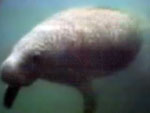

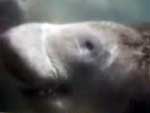
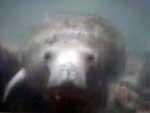
LeVar: This is remarkable. I've never been around this many huge animals in the water before. How big are some of the manatees here?
Mark: The male manatees, when they're adults, run about a thousand to twelve hundred pounds. The females run in the neighborhood of about two thousand pounds.
LeVar: That's a lot of weight. These animals are really, really large. You know Doctor, a lot of people don't think that manatees are very attractive looking, but I find them really beautiful.
Mark: Right. Well I think, the thing about manatees is that they're so ugly, they're cute.
LeVar: Now Becky, what's on the menu today? What are you feeding these manatees?
Becky: These are vitamin-mineral biscuits. We give them lettuce, cabbage and carrots.
LeVar: They're vegetarians.

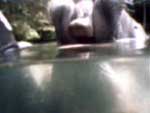
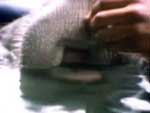
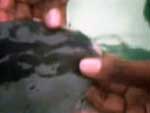
LeVar: So let's talk about where the manatee comes from Dr. Mark. They're descended from which animal do we think?
Mark: We think they're descended from the elephant. It's their closest relative on land. And they have a upper lip very similar to an elephant's trunk. Here we go with one reaching and grabbing. ... sort of like an elephant would reach and grab something...
LeVar: With the end of his trunk? They're sort of like fingers. Then of course the flippers and the nails on the flippers. They look like elephants' toes.
Mark: Very small nails. Very similar to the elephant.
LeVar: I love the way their skin feels.
Mark: And they do have sparse body hairs, very difficult to see, along their back you'll see some very fine hairs.
LeVar: Oh yeah!
Becky: Well, I think that makes them a mammal.
LeVar: Now, Manatees hold their breath like we do. Don't they?
Mark: Right. Just as they go under water, you'll notice there's a little valve on the nostril that closes and this keeps the water out of their nose. They breathe every three to five minutes on the average.
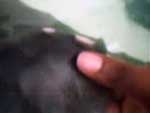
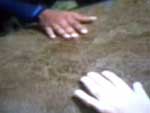
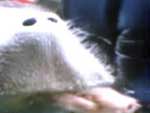
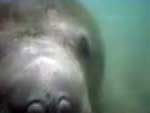
LIFE CHANGING TELEVISION
by Sharon Mooney
In the early part of 2000, I developed a strong interest in the Evolution-Creation debate. The evidence had always been available, for instance in the National Geographic magazine which my parents had subscribed to all their life, and on educational television stations like PBS, Discovery and The Learning Channel, but making the error that most young people do, I never paid a lot of attention to the information that was available to me.I began paying closer attention to the documentaries on the evolution-creation debate not so long ago, and was amazed by what I soon learned. The information is not new, but my attention span was. PBS broadcasted "Evolution, The Triumph of an Idea" in 2001, and upon seeing their presentation of land mammal to sea mammal, and all the causes scientists have for establishing a relationship between the two, amazed me. In November 2001, National Geographic magazine released "The Evolution of Whales", co-written by Professor Hans Thewissen (a world renown Paleontologist), a real life, modern day "Alan Grant" (Jurassic Park), as I tell people. The article contained images which appeared to indicate remains of hind limbs still exist in some whales.
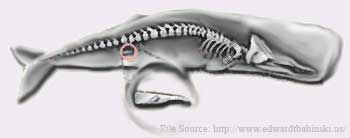
"Today's sperm whale has vestigial hind limbs."Based on an image found on Page 71, National Geographic MagazineNovember 2001, "The Evolution of Whales"
I took this information at face value, and simply accepted it as fact, without ever double checking if they had concrete empirical evidence such as photographs. This lead to later conflicts with Fundamentalist Creationists, who claimed there are no photographs. I faithfully believed that this Professor "Hans Thewissen" who co-wrote the article, would not lie. I believed National Geographic must be telling the truth. I had developed a fond trust of National Geographic magazine, since childhood. My parents were Creationists, but they had always subscribed to National Geographic, and encouraged my siblings and myself to read the magazines and books. We had a healthy respect for the National Geographic Society. I still appreciate the assistance they gave our family in matters of science. For instance, when we noticed a strange and beautiful woodpecker that showed up in our backyard. My mother wrote National Geographic, questioning which species of Woodpecker it is, explaining to them the location we lived at, and the general environment. A researcher from National Geographic replied, defining the exact species of woodpecker, explaining it's rarity -- we were lucky to have had one turn up in our backyard, it's diet, it's preferred habitat, and mating rituals. Later, as I was picking butterbeans (we lived on a farm) I noticed an odd species of lady-bug. This unusual insect was at times a peculiar dull shade of off colored orange-brown -- it was chameleonic, and would change colors -- including turning into sparkling gold, just like a drop of gold reflecting the sunlight -- too beautiful to believe it was real! I dubbed it the "Gold bug". I kept seeing this particular type of ladybug in our garden. I had to know more about this fascinating insect. I wrote National Geographic and they replied with the exact species and all pertinent information. I never had cause to question their authority on matters of animal biology.
After reading numerous claims that no photographs or evidence exists for hind limbs on whales, I began a search for those photographs. I believed photos *must* exist if scientists like this famous Professor Hans Thewissen would say "Vestigial hind limbs exist". The day I went searching, I did not find any photographs, but I did find an article written by a man, by the name of Edward T. Babinski (holding a Bachelor of Science in Biology) posted on EvC Forum."Does evidence of transitional forms exist ? (Hominid and other)" and I contacted him, inquiring on photographs.
"Ed" Babinski (as I've come to know him in the past couple years) went about the task of tracking down the actual photographs, and combining them with known research on hind limbs on modern whales.
Creationists denied the existence of hind limbs on whales, and Ed located the photographs which confirm the existence of limbs on whales. [I thank him for that.]
It is quite easy for Creationists to deny vestigial hind limbs on whales, due to the fact that cetacea (whales and dolphins) are so far along in the evolutionary process, that today little or no evidence remains in their anatomy to demonstrate thier evolutionary history. That is, to say for the common person with no background on biology or paleontology. For scientists, the evidence is abundant and overwhelming. But for the common person, such as myself, modern whales offer only limited evidence of their land-dwelling, quadruped ancestors. For me, that vestigial organs would slowly disappear on whales, is only a matter of common sense -- that is, if Darwinian natural selection is true, and I believe it must be. Aside of the rare fossil finds Paleontologists recover from obscure desert regions where oceans once existed, whales simply do not offer the kind of empirical evidence Creationists demand to see. To elaborate on this point, myself and Ed Babinski had the opportunity to correspond with Professor Hans Thewissen in 2003 on photographs contributed by the Milwaukee Public Museum of their Humpback and Pilot Whale Display, both of which contain vestigial Pelvis bones. Professor Thewissen explained, the mount in the museum does not contain the femur, because it is made of cartilage. That portion of the hind limb on the whale is missing, but yes, the whale has one.
However, this lack of visual evidence is not the case with Sirenians (Sea Cows, Dugongs, Manatee).
A note of interest for Sirenian lovers: Hans Thewissen has moved his site, and has added a page on Sirenian fossils!

Approximate Sirenian populations/locations.Image Source: Home ArchiveBased on information in National Geographic I had a life-changing experience a couple years ago viewing PBS Reading Rainbow episode "Sam the Sea Cow" where LeVar Burton visits various manatee / marine mammal preserves, including Sea World. I stood in awe [along with the information I'd picked up from the PBS "Evolution" series, and National Geographic's "Evolution of Whales"] as I saw LeVar Burton holding a manatee flipper in his hand, seeing it with my own eyes, these "elephant toenails" on a sea mammal! Including numerous other similarities with elephants that Dr. Lowe explained to LeVar Burton and the camera crew. I had trouble digesting that amazing video which you can see by visiting Sam the Sea Cow in Real Media Format. [Click on the "Preview this Video" link]. These are not "hypothesized" vestigial toenails. These toenails exist in our own time, that we can see with our own eyes, in this day and age! There is no denial of toe nails on manatees. The manatee perhaps, will lose their toenails in another twenty thousand years -- perhaps another fifty thousand years. Perhaps another million. Perhaps twenty million years from now. And, when nature has ran its course, and toenails have disappeared from sirenians (if they're not driven to extinction before that time), a Creationist, somewhere, will deny fossilized toenails on sea cows, as they have adamantly denied hind limbs on whales. We are living in a time, where the evolutionary process has not yet finished running its course with Sirenians. We are blessed to see the phenomena of evolution in progress! With Sirenians, unlike the majority of Cetaceans, it's getting there -- but it's not complete. The traces of toe nails (and other traits) remain on the Sea Cow. We're not so fortunate in the case of whales. We would have seen and taken for granted hind limbs on whales, had we lived thirty five million or more, years ago.
I am very pleased to have been granted permission by the Producers of Reading Rainbow to share this segment of "Sam the Sea Cow" which reveals the toenails and other traits in common with elephants. Along with the photographs (below), please do visit the PBS site and see the video segment for yourself here. [Click on the "Preview this Video" link].
Sam the Sea Cow about an injured Sea Cow rescued by marine biologists.
Celebrity host, LeVar Burton examines a Sea Cow close up revealing it's traits in common with elephants.
Sam The Sea Cow, WMV / Flash Format / Duration - 3:06
© 1992, Reading Rainbow
RR is a production and registered trademark of GPN/Nebraska Educational Telecommunications and WNED-TV, Buffalo NY
SIRENIANS EVOLVED SEPARATELY FROM CETACEANS: MANATEES RELATED TO ELEPHANTS
Manatees have tough, grayish-brown, wrinkled skin that feels like an elephant's skin. Scientists say that long ago, manatees used to live on the land and eat grass like elephants. Manatees have toenails just like an elephant too. Also, a manatee's big nose is like a short trunk. Manatees use their nose to grab plants and pull them into their mouth -- just like an elephant! Of course, manatees and elephants are very different. Since manatees live in the water today, they don't even have back legs.
Although scientists often lump sirenians together with the order Cetacea (whales and dolphins) as totally aquatic marine mammals, manatees and the dugong are actually more closely related to elephants, hyraxes, and aardvarks! This group of animals, commonly called sub-ungulates, shares an ancient African ancestor. Which makes manatees and dugongs more closely related to elephants than to dolphins or whales. In fact, scientists often find behavioral, physiological, and genetic similarities between manatees, dugongs and elephants. One major difference between cetaceans and sirenians is their diets. Whales and dolphins eat fish and plankton; some species, like the killer whale, even eat other whales and dolphins. Manatees and dugongs, like elephants, are herbivores. In fact, they are the ONLY marine mammal herbivores alive today! Their diet consists primarily of sea grasses and other aquatic vegetation.

AquaGenesis by Richard Ellis available at amazon.comBelow are some quotes found within the pages of the latter half of AquaGenesis. Richard Ellis has done a thorough job of discussing Sea Mammals and other relevant creatures who shared a land-sea environment in their evolutionary history.
SOME EXCERPTS FROM AQUAGENESIS
At many different times in the geological past, terrestrial animals abandoned the ecological accomplishments of their remote ancestors, the air-breathing fishes, to reinvade the sea. Ichthyosaurs, plesiosaurs, crocodiles, turtles, snakes, penguins, whales, and seals, to cite a few obvious groups, have established themselves very well in marine environments. In doing so, they have mimicked the shapes of fish. However, fish have effectively invaded the land only once, 365 million year ago, and these were the ancestors of succeeding land-dwelling backboned mammals. No fish has since emerged from the water to mimic the shapes of the dominant backboned animals on land. How is it that land-dwelling creatures, though initially adapted imperfectly to living in water, can successfully compete with the marine creatures whose ancestors never left the sea, but the reverse never occurs?
--Dale Russell, 1989"Because it spends most of its time on land or ice, and enters the water only occasionally, the polar bear is not usually considered a marine mammal. Ursus maritimus swims well, but only to get from place to place. During the past 25,000 years, it has evolved from a brown, temperate-zone, land-based bear into a white, semiaquatic, cold-weather bear, and is probably a marine mammal in the making.Richard Ellis (footnote), page 175, "AquaGenesis"
If you have collected fossils to any great extent in marine Tertiary deposits of tropical or once-tropical latitudes, you have probably come across cylindrical pieces of thick, dense, vertebrae bone several centimeters in diameter that someone told you were the ribs of sirenians, or seacows. You may even have learned to apply the term "pachyostotic" to such bones. Inquiring further, you probably learned that seacows (manatees and dugongs) are the legendary mermaids, that they are the nearest living relatives of elephants, and that they all replace their teeth horizontally, back to front, just like elephants do. Such is education: a random mixture of truth and error, hopefully favoring the former.
--Daryl Domning, 1999Mimicry is a difficult concept to justify in terms of natural selection. How is it possible for totally different animals to have achieved the same shape, coloration, and size? Or for a creature to develop an imexplicable resemblance to a unrelated species, as with the dwarf sperm whales' "gills"? The leafy sea dragon, a sea horse, has evolved a costume of frilly protuberances that make it disappear in the weeds and coral near which it lives. The same is true of the sargassum fish, which looks almost exactly like the sargassum weed in which it lives. Occassionally we read that these creatures grew to look like leaves or plants so that they could fool predators, but this suggests a determinism that Darwinists say is completely lacking in the evolutionary process. Richard Dawkins (1996) sees no problem at all with 'mimicry', writing that "it is enough to say that we are sure this resemblance, and other examples of 'mimicry', are not accidental. They are either designed or they are due to some process that produces results just as impressive as design." His final answer? "That magnificently non-random process which creates an almost perfect illusion of design . . . .Darwinian natural selection."
--Richard Ellis, (footnote), page 235, AquaGenesisSome groups of mammals became completely aquatic like the whales and the Sirenia (dugongs and manatees), others like seals almost so, and many others, such as Polar bears, otters, beavers, water voles, etc., became partially aquatic. I then put forward the thesis that perhaps man himself had such a phase of semiaquatic life.
--Sir Alister Hardy, 1960 quoted by Richard Ellis, page 243The news about the aquatic descent of elephants was startling enough to make many newspapers and television news programs when the paper was published in May 1999, but Elaine Morgan was way ahead of Gaeth, et al. In her 1985 revision of 'The Descent of Woman', she wrote:
"We know that one of the elephant's nearest kin went into the sea and stayed there permanently, for the elephant's closest cousin is the sea cow. We know that early species of elephant developed weird and pointless-looking dental arrangements quite useless to land dwellers. There were, for instance, the shovel-tuskers, Ambledone and Platybelodon grangeri. Now shovels and spoons as a natural endowment are invaluable to water-feeders, like ducks and spoonbills and platypuses, but why on Earth would a land-dwelling animal want to scoop up a shovelful of Earth? Another primitive elephant had tusks that pointed down, like a walrus's."
Elephants are good swimmers now, so there is every reason to assume that they were good swimmers in the past, and for swimmers, she wrote "a snorkel makes sense."
--Richard Ellis, page 250-251, AquaGenesisThe earliest fossils were found in Hungary, but they are fragmentary and give little idea of what the animal actually looked like, or even whether it was aquatic. The Middle eocene sea cow, Prorastomus sirenoides, was found in Jamaica in 1855, but again not enough material was available to reconstruct that animal. Additional fossil material has been found in Jamaica, but, wrote Savage, Domning, and Thewissen (1994), "This odd little sea cow has been a difficult morsel for science to digest." Nevertheless, Prorastomus sirenoides "is the best available approximation to a structural ancestor of the Sirenia," and was "probably an amphibious but mainly aquatic quadruped that inhabited coastal rivers and embayments. It was probably a selective browser on floating and emergent aquatic plants and, to a minor degree, on sea grasses."
--Richard Ellis, Marine Mammals - "The Sea Cows", AquaGenesis, Page 177Whatever other appellations might be applied to these animals, "beautiful" is not the first one that springs to mind. Although they bear a superficial resemblance to some of the other marine mammals such as pinnipeds and cetaceans, sirenians have no evolutionary relationships with them. In fact, paleontologists have classified them as subungulates and lumped them together with such varied company as elephants, hyraxes, and aardvarks. Like the sirenians, all these animals lack a clavicle (collar bone) and have nails or hooves instead of claws.
--Richard Ellis (footnote, page177)The first manateelike animla, dating from about 15 million years ago, was Protosiren, yet it lacked the replacement teeth that enable modern manatees to eat abrasive plant material. Recently, Domning and Gingerich (1994) suggested that Protorastamus and Protosiren were quadrupedal amphibious creatures that lived along the seashores. What did they look like? Domning (1991) wrote, "The Seven Rivers [Jamaica] prorastomids, which are slightly more derived than Prorasatomus itself, were pig-sized quadrupeds with long trunks, and a substantial though not powerfully-muscled tail." Certain anatomical characteristics "indicate that they were more aquatic than modern hippopotami; they probably fed as well as rested in the water, but at least the earlier of them could probably support their weight onland. In a 1916 paper, "Sea Cows, Past and Present," Frederic Lucas wrote: "It would of course be one link in the chain, one step towards a four-footed animal, if we could find a four-paddled porpoise, but none has yet come to light, and here is where the sea cow comes forward with an important bit of evidence. When paleontologists were hunting in the Fayum, Egypt, for ancestors of existing elephants, they came upon the remains of a manatee, not unlike those of today, save that it possessed four well-developed paddles; and because it was so evidently the predecessor of the modern sea cows, it was named Eosiren," from Eos, the Greek goddess of dawn. In fact, says Domning, "Eosiren libyca (late Eocene) had vestigial hind limb bones, but the hind limbs probably did not show on the outside of the body. In no case have we actually found a complete hind foot for any of these, paddlelike or otherwise. Lucas's statement is a broadly valid inference based on the pelvic bones, which were the only relevant elements available in his time" (personal communication, 2000).

AquaGenesis by Richard Ellis available at amazon.comThe above quotes were excerpts from Richard Ellis' AquaGenesis which I highly recommend to anyone who wishes to find a book covering an indepth history of animal life from their beginnings in the ocean to where they emerged on land, and beyond.


No comments:
Post a Comment